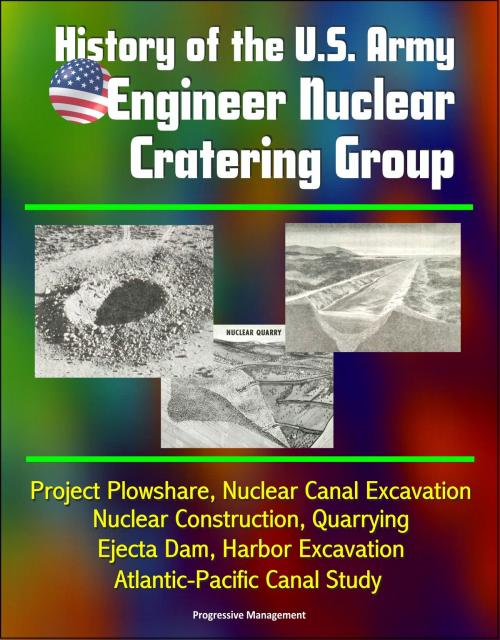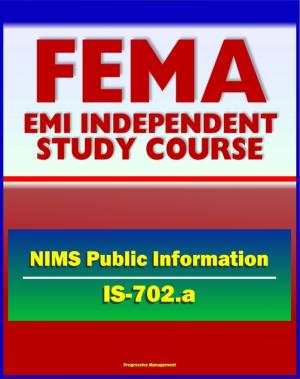History of the U.S. Army Engineer Nuclear Cratering Group: Project Plowshare, Nuclear Canal Excavation, Nuclear Construction, Quarrying, Ejecta Dam, Harbor Excavation, Atlantic-Pacific Canal Study
Nonfiction, History, Military, Nuclear Warfare, Science & Nature, Technology, Engineering, Civil| Author: | Progressive Management | ISBN: | 9781311215000 |
| Publisher: | Progressive Management | Publication: | September 27, 2014 |
| Imprint: | Smashwords Edition | Language: | English |
| Author: | Progressive Management |
| ISBN: | 9781311215000 |
| Publisher: | Progressive Management |
| Publication: | September 27, 2014 |
| Imprint: | Smashwords Edition |
| Language: | English |
This history, written in 1969, outlines the work of the Army Engineer Nuclear Cratering Group on using nuclear blasts for civilian construction projects. In April 1962, the President of the United States directed that the United States undertake further basic economic and technical investigations to provide the basis for examining the question of, the need for and the method of construction, location and cost of a sea-level interoceanic canal in the Isthmian region. Such investigations were to include research to determine within approximately the next five years the feasibility costs and other factors involved in various methods of excavation. To implement this Presidential policy guidance, the Chairman of the U. S. Atomic Energy Commission was directed to establish within the PLOWSHARE Program a research goal to determine within approximately the next five years the feasibility, costs and other factors involved in nuclear methods of excavation. It was determined that the necessary research program would be a joint responsibility of the Atomic Energy Commission and the Department of Defense in accordance with an initial agreement between these two agencies. To this end, the Secretary of Defense was directed to arrange, under civil functions, for the participation of the U. S. Army Corps of Engineers in a joint research program with the Atomic Energy Commission. In May 1962, the Under Secretary of the Army authorized the Chief of Engineers to activate and staff the U. S. Army Engineer Nuclear Cratering Group, Corps of Engineers, at Livermore, California, to participate jointly with the Lawrence Radiation Laboratory in the technical planning, management and execution of the research program on nuclear methods of excavation.
SECTION I - Establishment of the U. S. Army Engineer Nuclear Cratering Group * SECTION II - Mission and Management of Research Program * SECTION III - Organization and Functions * SECTION IV - NCG Directors - Past and Present * SECTION V - The NCG Experimental Cratering Program * SECTION VI - Engineering Studies of Project Feasibility * SECTION VII - Engineering Properties of Nuclear Craters Investigations * SECTION VIII - NCG Interoceanic Canal Studies Activities * SECTION IX - Military Engineering Studies Program * SECTION X - Nuclear Construction Concept and Applications * SECTION XI - Current Major Programs * SECTION XII - Summary * REFERENCES * TABS * A. General Orders No. 8 * B. Letter of Understanding between the Lawrence Radiation Laboratory and the U. S. Army Corps of Engineers * C. Interagency Support Agreement between U. S. Atomic Energy Commission, San Francisco Operations Office and U. S. Army Engineer Nuclear Cratering Group * D. Nuclear Cratering Group Technical Reports Completed through 31 January 1969
This history, written in 1969, outlines the work of the Army Engineer Nuclear Cratering Group on using nuclear blasts for civilian construction projects. In April 1962, the President of the United States directed that the United States undertake further basic economic and technical investigations to provide the basis for examining the question of, the need for and the method of construction, location and cost of a sea-level interoceanic canal in the Isthmian region. Such investigations were to include research to determine within approximately the next five years the feasibility costs and other factors involved in various methods of excavation. To implement this Presidential policy guidance, the Chairman of the U. S. Atomic Energy Commission was directed to establish within the PLOWSHARE Program a research goal to determine within approximately the next five years the feasibility, costs and other factors involved in nuclear methods of excavation. It was determined that the necessary research program would be a joint responsibility of the Atomic Energy Commission and the Department of Defense in accordance with an initial agreement between these two agencies. To this end, the Secretary of Defense was directed to arrange, under civil functions, for the participation of the U. S. Army Corps of Engineers in a joint research program with the Atomic Energy Commission. In May 1962, the Under Secretary of the Army authorized the Chief of Engineers to activate and staff the U. S. Army Engineer Nuclear Cratering Group, Corps of Engineers, at Livermore, California, to participate jointly with the Lawrence Radiation Laboratory in the technical planning, management and execution of the research program on nuclear methods of excavation.
SECTION I - Establishment of the U. S. Army Engineer Nuclear Cratering Group * SECTION II - Mission and Management of Research Program * SECTION III - Organization and Functions * SECTION IV - NCG Directors - Past and Present * SECTION V - The NCG Experimental Cratering Program * SECTION VI - Engineering Studies of Project Feasibility * SECTION VII - Engineering Properties of Nuclear Craters Investigations * SECTION VIII - NCG Interoceanic Canal Studies Activities * SECTION IX - Military Engineering Studies Program * SECTION X - Nuclear Construction Concept and Applications * SECTION XI - Current Major Programs * SECTION XII - Summary * REFERENCES * TABS * A. General Orders No. 8 * B. Letter of Understanding between the Lawrence Radiation Laboratory and the U. S. Army Corps of Engineers * C. Interagency Support Agreement between U. S. Atomic Energy Commission, San Francisco Operations Office and U. S. Army Engineer Nuclear Cratering Group * D. Nuclear Cratering Group Technical Reports Completed through 31 January 1969















